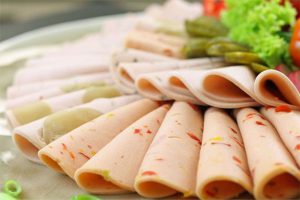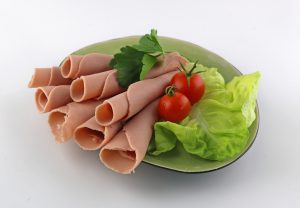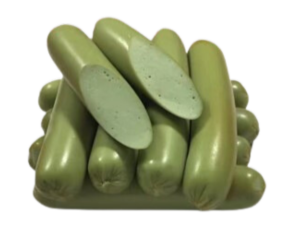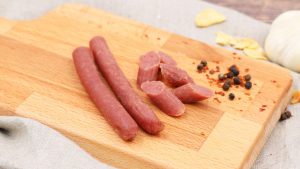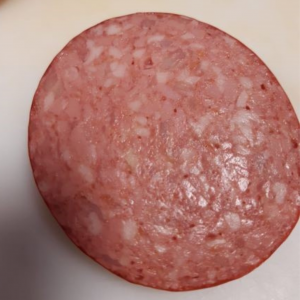Meat grinding for Sausages
The purpose of the grinding process is to reduce meat to the required particle size. The fat is usually ground through a plate with very small holes and if the meat is not partially frozen, a creamy paste is produced. The washer on the head of the grinder must be tight and the blade must be sharp. Otherwise, the meat would smear and the sausage would look greasy, even if lean meat was used. Ideally, meat should always be refrigerated between 32-35°F (0-2ºC) for a clean cut. Since the temperature in the refrigerator is about 38-40°F (3-4ºC), the meat should be placed in the freezer for about 30 minutes just before grinding. In domestic conditions, the choice may be made to cut the meat early in the morning or late in the evening when the temperature does not exceed 21°C.
After we are done cutting the meat, we should separate it into separate groups: lean, semi – fat, and fat. The lean meat should be separated from the fat. As a rule, lean meat is ground coarsely while fatty cuts are ground very finely. This way our sausage is lean-looking and the fat is less visible. It is much easier to grind cold meat taken directly out of the refrigerator. Then they should be placed back into the refrigerator. It is possible to buy minced meat in a supermarket, just make sure it has been minced the day of the purchase. Such minced meat should be processed not later than the following day.
What quality of meat to grind through which plates?
The question may arise, why do we grind different grades of meat through different plates? It will be much easier to use a 3/8″ plate for everything.
There are many reasons for this:
- You could do that if you had only high quality meat, let’s say pork class I (ham) and pork class II (butt). With such fine meat, you wouldn’t get bits of bone, cartilage or sinew that would get stuck between your teeth. In contrast, we are left with lower grade meat scraps that we would not be able to eat if they were not finely ground.
- The second reason is that we want to keep meat juices and water in the meat and the lower classes of meat with lots of cartilage and tendons are full of collagen, which actually helps to do that. The better we can grind, the stronger the binding power of the meat and this is where a bowl grinder begins to shine. A grinder, manual or electric, cuts meat and pushes meat through plate holes, cutting the meat but also mechanically breaking it up at the same time.
A bowl cutter cuts cleanly without doing mechanical damage to the structure of a piece of meat. It develops a lot of heat, so ice or cold water is added to cool the meat and the rotating blades. This allows the meat to emulsify to a consistency of fine paste that can capture and hold all that ice and water. All the meat residue with fat, cartilage and sinew has now become a paste, the product will be juicier and the manufacturer will make more money by charging the customer for this trapped ice and water. This is exactly how we make products like hot dogs, frankfurters, bologna or liverwurst. - The third reason is that today a lot of fat is used to make sausages and that fat is visible to the naked eye when we cut the sausage. By grinding the fat through a fine plate, the fat will bind with the meat and not be detectable. You now understand that there is no rigid, fixed rule for grinding plates and that the choice of plate depends greatly on the type of sausage you decide to make.
For hundreds of years, we chopped meat with knives and put our fingers through a horn. And the sausages were delicious.
Queen Victoria of England had her own strict rules for making her sausages: The meat had to be chopped, not ground to prevent the natural juices from leaking out. And the casings had to be filled by hand, the mixture pushed through a funnel with your thumbs.
Show Meat in sausages
Some products require meats which are not ground but diced or cut with a knife. Their texture displays solid chunks of meat or fat inside, including even nuts or olives. For example Mortadella is often made with pistachio nuts, some sausages have whole peppers. Sopressata has large pieces of fat inside. There are liver sausages that have cubes of fat or ham sausages with solid chunks of meat inside. This is done for a decorative purpose only and such a sausage does not have more fat than others. Were this fat emulsified with the rest of meat we would not be able to see it, though it would still be inside.
Krakowska sausage incorporates chunks of lean meat used as show material. The meat chunks must be perfectly lean and pork ham is a good cut for that.
Sopressata sausage – fat used as show material.
Machines for grinding meat
The typical machines for grinding meat for sausages are:
Dicer
Dicer cuts into uniform size cubes that may be used in many dishes or specialized sausages. For example Polish Krakowska sausage is made with visible chunks of meat. It is very unlikely that a hobbyist will need such a machine as he can perform the same function with a sharp knife.
Photo’s courtesy Koch Equipment, Kansas City, MO.
Koch SR-1 Turbo Dicer. Dicer can slice a variety of foods.
Grinder machines
Grinder is the most popular machine that has been around for a long time. There are many commercial brands on the market and some units can grind and mix at the same time which saves time and space. They differ mainly in their output capacity. Grinder as the definition implies, grinds meat and pushes it through the plate, it does not produce a perfectly clean cut. There is a large amount of pressure on meat in the feed chamber. This leads to tearing between the auger and the walls of the chamber. As a result the meat is not cut as good as with a bowl cutter. This will be more pronounced when the knife is blunt.
It is much easier to grind cold meat taken directly out of the refrigerator. Ideally, meat should always be chilled between 32-35° F (0-2º C) for a clean cut. The fat should be partially frozen or a smeared paste will be produced. When a recipe calls for a second grind, refreeze the first grind and then grind it again. When making emulsified sausages, this operation may be repeated 2-3 times.
Electric grinder for light commercial use. Some grinders come equipped with an easy to assemble attachments for the mixer or chopping machines. Grinding output from 34 lbs per min and up, depending on product type, feed rate, plate hole size, etc. Photo courtesy Sausage Maker, Buffalo, NY.
Thompson 900 Mixer/Grinder is suitable for small to medium processors or supermarkets. Grinder is capable of mincing 4,000 lbs of meat per hour. Photo courtesy Koch Equipment, Kansas City, MO.
At home the manual grinder is the machine of choice.
There are basically 5 types of hand operated grinders: No 5, 8, 10, 22, 32, the most common being 10, 22, 32 and the most popular # 10.
| Manual Grinders | |||
|---|---|---|---|
| Model | # 10 | # 22 | # 32 |
| Plate diameter | 2-3/4″ | 3-1/4″ | 3-15/16″ |
| Center hole | 3/8″ | 7/16″ | 9/16″ |
| Knife (square hole) | 7/16″ | 1/2″ | 9/16″ |
#22 and 32 size grinders are heavy enough to rest on the table but they are usually clamped to it. All the above grinders employ a variety of accessories, such as grinder plates, knives, stuffing tubes, jerky attachments, and more.
| Plate holes | |
| inches | millimetres |
| 1/16 | 2 |
| 1/8 | 3 |
| 3/16 | 5 |
| 1/4 | 6 |
| 3/8 | 10 |
| 1/2 | 12 |
| 5/8 | 16 |
| 3/4 | 19 |
| 1″ | 25 |
Grinder plates come in varied sizes.
Different plates having the same hole diameter.
There is an optional plate (with three big holes) that is used to initially break up the meat into smaller pieces. These pieces will be cured, and then ground again through the right plate.
Spacer. Knife and grinder plate are always removed for stuffing. It is a clever idea to insert the spacer, although not necessary.
To keep meat smearing to a minimum, the knife should be perfectly aligned with the plate. Always send them together for sharpening.
All the above work fine, but for grinders, the bigger the better. Bigger models have a larger throat, and they will grind the meat faster. However, they are also heavier, more expensive, and require more space to store. The knife must be sharp, otherwise the meat will smear. The process will come to a stop as the connective tissues will wrap around the knife preventing further cutting. The locking ring on a grinder head should be tight. After a while the meat will lubricate the grinder and the crank will begin to turn with ease. Bear in mind that the grinder, whether electric or manual, generates heat and if it were washed in hot water, it should be cooled off before use.
Home grinders come in the following sizes: 8, 10, 22, 32, number 10 being most popular. It is a fine general purpose grinder for making smaller amounts of sausage. If you think about mincing 20 lbs. of meat or more get #32. It has a bigger throat, bigger knife and bigger plate diameter. If the recipe calls for a large grinder plate like ¾” and you don’t own it, dice meat with a knife, this is how we made sausages in the past.
What grinder to buy?
Although an electrical machine looks impressive, the question to ask is how much meat are we going to process? Manual grinders are wonderfully designed and very efficient machines which are very inexpensive. On the other hand, small home type electrical models cost more and work twice as fast at best. The only difference is that you don’t have to exercise your hand for 5 minutes. To get any significant output (50 – 100 lbs. per minute) you must buy a big industrial model which is heavy and expensive. It is our opinion that it is wiser to invest extra money on a quality piston stuffer and grind meats manually. These are general estimates for the output ability of different grinders:
Manual
| Type | Capacity in lb per min. |
|---|---|
| # 10 | 2-3 |
| # 22 | 3-4 |
| # 32 | 5 |
Electric (Home Quality)
| Type | Capacity in lb per min. |
|---|---|
| # 10 | 5 |
| # 22 | 9 |
| # 32 | 12 |
Most recipes on the Internet ask for between two and five pounds of meat. This means that most people use less than one pork butt (around 6 lbs.) of meat. Number 32 manual grinder will perform this task in 1½ minute. Number 10 grinder will do it in 2 minutes. An electrical model will be faster but what’s the hurry? If you plan to make 50 pounds of sausage, yes, you hand will get tired and the electrical model is a logical choice.
Bowl Cutter
Bowl cutter – also known as buffalo chopper or silent cutter, cuts meat very finely and is a must have machine for commercial production of emulsified products such as bologna or hot dog.
Both the speed of the turning anti-clockwise bowl and rotating knives is adjustable. The stainless-steel bowl turns about 14-16 times per minute and the knives rotate about 3,000 times per minute.
Bowl cutter.
Photo courtesy Koch Equipment, Kansas City, MO.
The resulting friction generates so much heat that the meat will boil and cook. To keep the temperature down the flaked ice is added to the mixture. As the meat is finely comminated, a lot of protein is released which in combination with salt and phosphates can easily absorb melting ice and resulting water. The mixture becomes a fine paste which after stuffing becomes hot dog, bologna or any emulsified sausage.
Adding spices. The built-in thermometer allows to control temperature of the sausage mass.
Photo courtesy Koch Equipment, Kansas City, MO.
Koch Equipment AS40 Bowl Cutter.
The bowl cutter can be employed to make any kind of a sausage except fermented or air-dried products. Technology of making these products is based on the removal of moisture therefore adding ice to the mixture will jeopardize the safety of the sausage.

